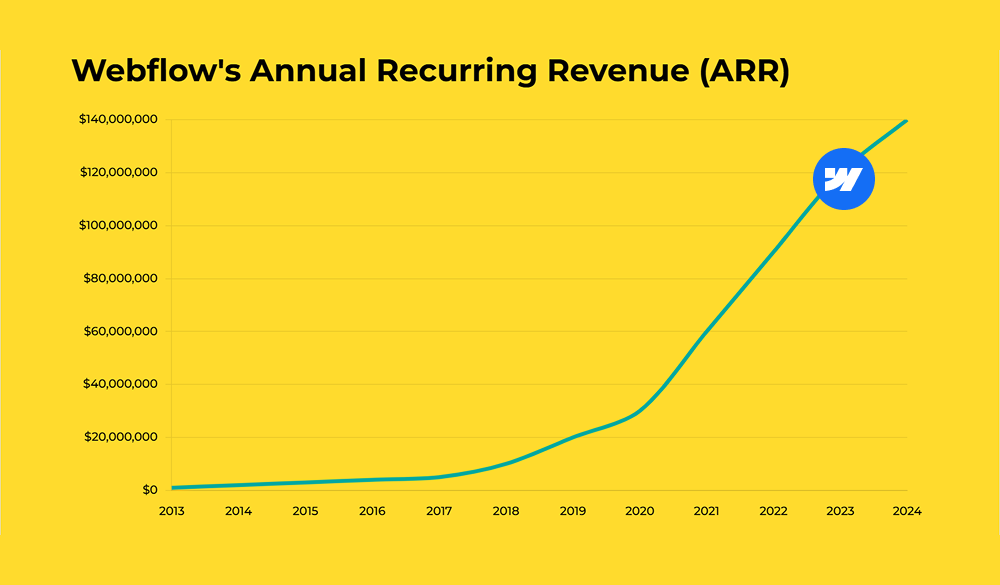“No-code? Really?” We recall thinking, skeptical but curious, when the buzz around Webflow CMS first began.
And why not? We’ve been in the business since the days when the web belonged to developers. If you wanted to break free from the drag-and-drop molds, you needed code—lots of it.
However, the no-code trend emerged, giving everyone, not just developers, a master key.
And Webflow? It didn’t just ride the wave; it defined it.
From its early days as a daring newcomer, Webflow has spent ten years establishing itself as a mainstay of the no-code revolution in web development.
Between 2020 and 2023, Webflow’s powerful yet intuitive CMS and design flexibility sparked a 138% increase in its user base.
Having been immersed in web development for years, we’ve watched as our clients pushed the boundaries of what’s possible—and seen firsthand how Webflow has evolved into a market leader.
In this blog, we’ll unpack the secret sauce behind the rise of Webflow and reveal why it’s rapidly becoming the platform of choice for leading brands and creative teams worldwide.
If you’re asking yourself whether Webflow can really handle your business site, we’ve looked at it closely in an honest and unbiased way here.
Webflow content management system – the evolution timeline
The early days of web design (2004–2011)
- 2004: Vlad Magdalin, the cofounder of Webflow CMS, interns at a web design agency. The job was to convert designers’ work into code. He notices clients pay thousands, but coders and designers are underpaid. This inspired the idea to empower designers to implement their own work without relying on developers.
- 2004–2008: Vlad experiments with Webflow as a side business while working full-time. He tests prototypes on real clients, iterates manually, and automates processes gradually. Early attempts fail, but his partnership with brother Sergie, a designer, begins to solidify.
- Late 2011: Vlad secures the Webflow trademark after a 5-year dispute. He interprets this as a signal to reinvest. Inspired by Bret Victor’s “Inventing on Principle” video, he quits his job at Intuit and reunites with Sergie to restart Webflow full-time.
The founding vision: 2012–2013
- 2012: The Webflow concept is solidified by Vlad and Sergie Magdalin, along with Bryant Chou. The mission: give designers the power of code without manually writing it and democratizing web design.
- March 2013: Webflow launches a demo playground. It resonates well with designers and developers. Post going viral on Hacker News generates 20,000 sign-ups and critical early hype.
- August 2013: That momentum carries Webflow into Y Combinator’s Summer 2013 batch. The team officially launches the website builder. And secures $2.9 million in seed funding.
Early growth: 2013–2015
- Webflow adopts a product-led growth model. Free plans with self-serve upgrades, and founders personally respond to customer queries.
- Freelance web designers become early adopters and evangelists, driving organic growth.
- Bryant notes: “Every freelancer we converted would then find businesses to build websites for, effectively becoming our distribution channel.”
- Viral experiments, like Flexbox Froggy and content marketing initiatives help Webflow expand awareness.
- 2015: To survive cash constraints, the team focuses on revenue growth, slowly hiring to accelerate product development. Customer retention becomes a priority through hands-on support.
Building features and credibility: 2014–2018
- 2014–2015: Webflow develops its visual canvas, translating design choices directly into HTML and CSS. Core users: freelance designers and small businesses.
- 2016: Launch of Webflow CMS enables dynamic content, custom fields, and data bindings. Designers can produce professional websites without additional plugins.
- Webflow University comes into view as a free learning hub. The community and new users expand.
- Agencies and startups adopt Webflow CMS and create scalable, maintainable websites.
- What really won over developers, Bryant says, was the code quality. Webflow outputs “super clean” HTML, CSS, and JS.
Joining the no-code trend in web development: 2018–2020
- Although the term “no-code platform” wasn’t born with Webflow, the CMS found its place in the early no-code ecosystem alongside Airtable, Zapier, and Bubble.
- Vlad’s words — “The future of web design is not code” capture Webflow’s mission to hand designers full creative freedom minus the manual coding.
- 2019: Ryan Hoover highlights Webflow Content Management System in Product Hunt, cementing its position as a no-code trailblazer.
- Series A funding of $72 million validates growth. Paying customers include freelancers and Fortune 500 companies, such as Johnson & Johnson and Yelp.
- Webflow moves from visionary early adopters to pragmatic mainstream users.
Enterprise adoption and ecosystem growth: 2021–Present
- Bryant identifies the enterprise opportunity through demand signals, e.g., a digital bank in Australia needing proper contracts and security.
- Webflow introduces enterprise features: single sign-on (SSO), roles and permissions, and branching for collaborative work.
- Early freelance adopters become enterprise partners, helping translate value and assist during sales cycles.
- The go-to-market motion evolves: product-led growth plus a sales team targeting companies phasing out legacy tools.
- Messaging pivots to emphasize visual canvas + powerful websites without heavy developer dependency.
- Webflow CMS has grown into a tool used by freelancers, agencies, and large companies alike, yet its core belief is the same—liberating creators from coding roadblocks.
- These days, Webflow is more than a website builder. It’s a rich ecosystem with AI-assisted design, multisite management, branching and staging, and advanced eCommerce features.
Webflow by the numbers: Tracing its steady ascent through the years
- At first glance, 1.2% market share seems modest, yet for Webflow—challenging long-standing CMS leaders—this number reflects meaningful growth and influence.
For a deeper look at Webflow CMS vs WordPress, check out this detailed comparison by Mavlers.
- The company’s valuation has reached $4 billion, as it nears the milestone of $100 million in annual recurring revenue within a month.

- From 320,000 sites in early 2024, Webflow’s active websites grew to nearly 493,226 by April 2025. That’s steady growth.
- Ecommerce sites on Webflow have exploded, growing more than sixfold over recent years, reaching almost 12,500 stores by mid-2024.
- Webflow CMS powers over 3.5 million designers and teams across 190 countries, with more than 100,000 opting for premium plans.
- Big brands like Upwork, Discord, Zendesk, Rakuten, and Dell trust Webflow website builders to handle their high-traffic, complex websites.
- Webflow’s no-code approach meshes well with the growing web development trend. Gartner predicts that by 2023, “citizen designers” will outnumber professional developers four to one at large companies.
- Competing platforms like Weebly hold about 0.7% of the CMS market share. Yet, Webflow wins through creative freedom and technical reliability.
- Webflow SEO capabilities and clean, semantic code make it easy for businesses to rank well. Many are looking to encash these benefits of Webflow CMS.
Contributing factors to Webflow’s growth & key CMS features
- Visual builder: Lower the technical barrier to building websites with a drag-and-drop interface without coding.
- Accessible web design: Opens doors to entrepreneurs, creatives, and hobbyists without requiring coding skills.
- Thriving community: Users exchange templates, tips, and inspiration, making learning and support easier.
- Constant updates: New features, tutorials, and improvements keep the platform competitive.
- Business & enterprise ready: Agency and enterprise programs help scale projects with dedicated support.
Core Webflow CMS features that matter
- Designer: Visual building that generates clean HTML, CSS, and JS behind the scenes.
- Editor: Safe, simple content updates without affecting design.
- Reliable Hosting: Powered by AWS and Fastly for guaranteed 99.99% uptime and fast global content delivery.
- Webflow for developers: No coding needed, but advanced users can add custom code for specialized functionality.
To sum it up —
Webflow’s journey from a small startup to a leading web design platform has earned it accolades for its pathbreaking approach.
Companies are increasingly understanding that they can publish and update web content quickly and inexpensively using no-code methods, rather than relying solely on developers.
It’s beyond dispute that Webflow CMS will play a major role in a future where building websites is simpler, faster, and smarter than ever.
The road ahead
If you are someone who has a Webflow website, you might be interested in reading ~



Urja Patel - Content Writer
Urja Patel is a content writer at Mavlers who's been writing content professionally for five years. She's an Aquarius with an analyzer's brain and a dreamer's heart. She has this quirky reflex for fixing formatting mid-draft. When she's not crafting content, she's trying to read a book while her son narrates his own action movie beside her.
Seasonal fatigue in paid media: The hidden reason holiday ads don’t always win
How AI-powered JIRA transforms multi-project management